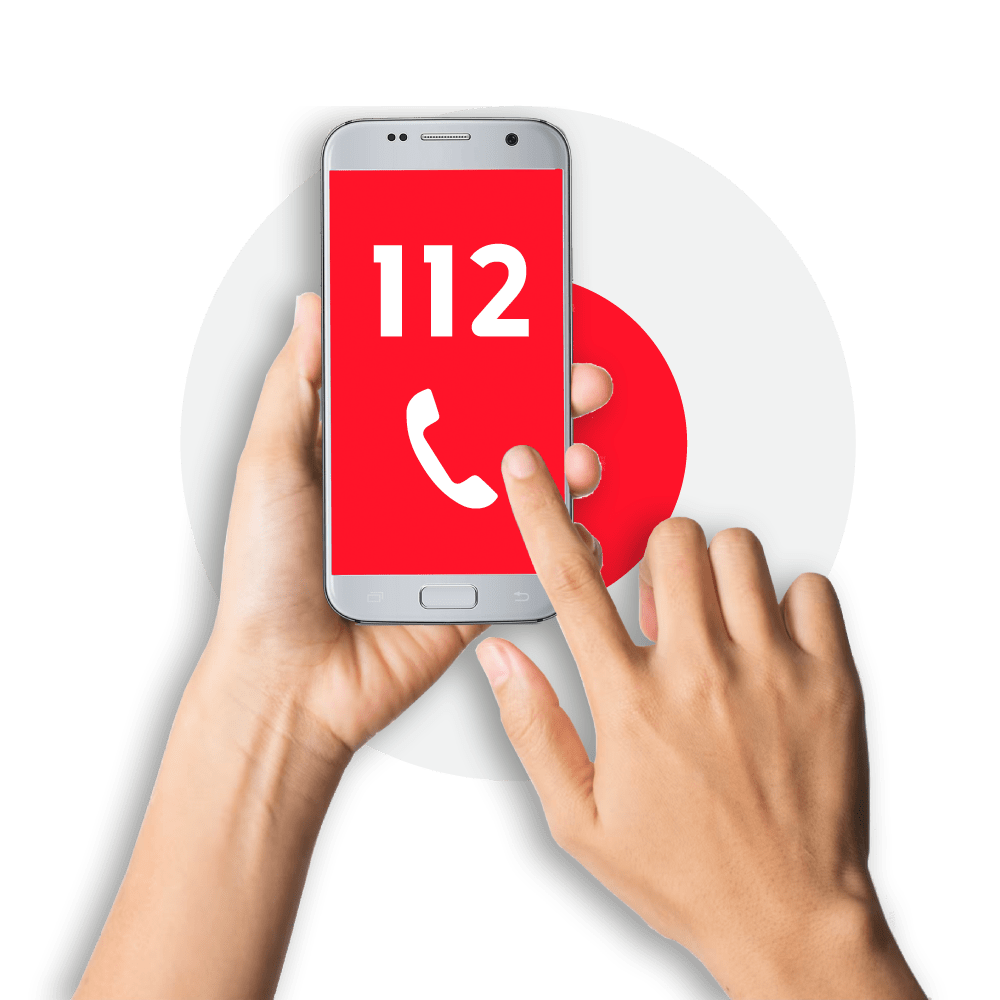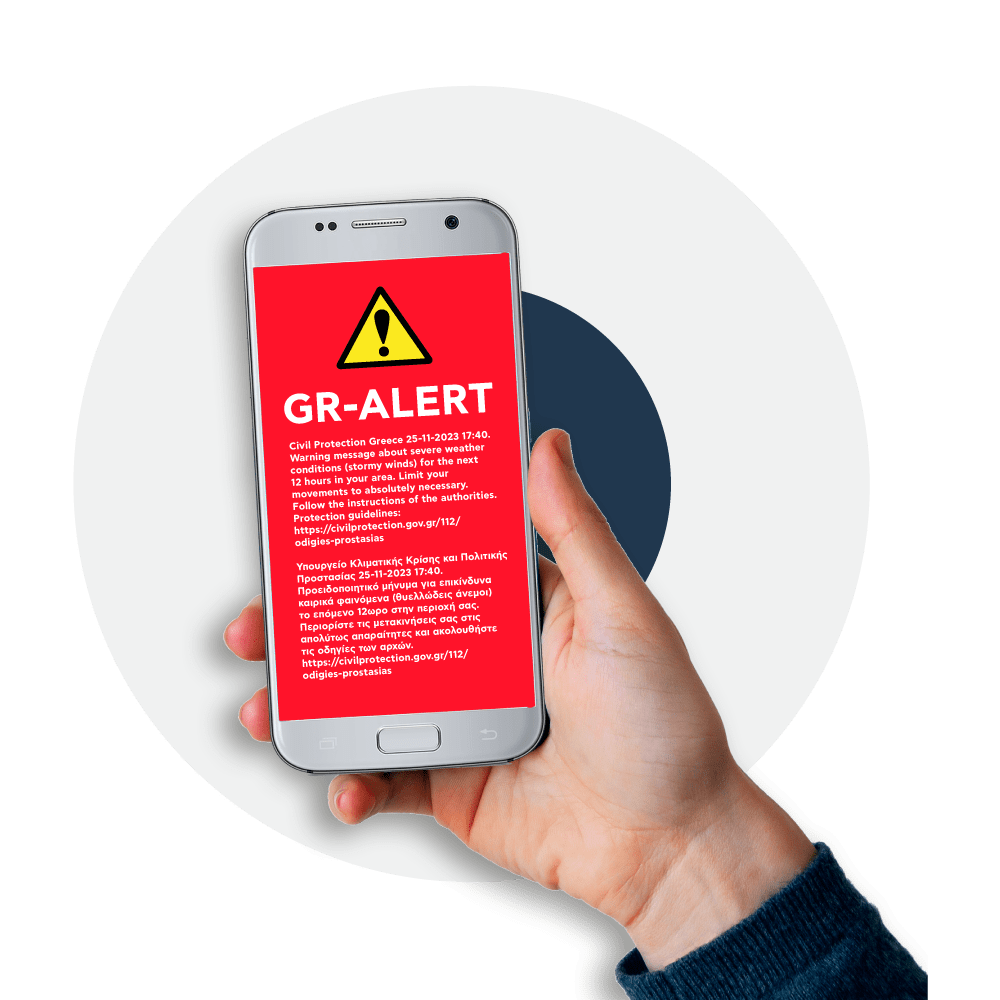FAQ (Frequently Asked Questions)


FAQ - When & how to call
What is 112?

112 was established by the European Union as the single emergency number. It is used to call emergency services in all EU countries, free of charge, facilitating access to these services in cases where a citizen needs immediate assistance.
With which emergency agencies/services is 112 interconnected?

Citizens call 112 when they are in an emergency and need immediate assistance from:
- the Hellenic Police
- the Hellenic Fire Service
- the Hellenic National Center for Emergency Care – EKAV
- the Hellenic Coastguard
- the National Helpline for Children SOS 1056
- the European Hotline for Missing Children 116000
- the European Helpline for Children and Adolescents for serious emergencies related to violence 116111
How can I contact 112?

You can contact 112:
- from a landline telephone
- from a mobile phone, even
- without a SIM card
- from a locked device, from the initial activation screen
- from public payphones, even without a calling card
- by text message (SMS) or multimedia message (MMS)
- by email at contact@112.gov.gr
- via the free app "gov.gr" available in the App Stores (for smartphones)
Is there a charge for calls to 112?

Calls to 112 are free of charge from a landline or mobile phone.
I don't have signal on my mobile. Can I call 112?

Calls to 112 can be made from any mobile telephony network. Even if you are out of range, calls to 112 are supported by other mobile networks that cover the area (national and international roaming service).
When can I contact 112?

In Greece, 112 operates 24 hours a day, seven days a week, throughout the year.
Who answers 112?

Phone calls are answered immediately by specially trained operators. In addition, the 112 call center is staffed with representatives of the competent emergency service providers (Hellenic Police, Hellenic Fire Service, Hellenic Coastguard, National Center for Emergency Care - EKAV).
In which languages can I contact 112?

The 112 operators answer in three languages: Greek, English and French.
What information do I need to give to 112?

When you call 112, you need to mention the type of emergency and the location of the incident. Operators will ask questions to determine what type of assistance is needed.
When you text 112, it is important to include the answers to the following:
- What has happened?
- Where has it happened?
- When did it happen?
- Are there any injured individuals?
What should I do, if I accidentally call 112?

It is important not to hang up the phone without speaking. Let the operators know that the call was a mistake, otherwise there will be unnecessary mobilisation of help, which others may urgently need at that time.
What is eCall and how is it connected to 112?

It is a system that as of 31/03/2018 is mandatorily installed in all vehicles in the EU and which calls 112, automatically and free of charge, in the event of a serious road accident.
When the eCall is activated, it gets connected to the 112 centre via a telephone and data link. This makes it possible to communicate with all vehicle passengers, while at the same time the data transmitted (exact location, vehicle direction, accident time, vehicle identification number) allow the more direct management/response to the incident.
The eCall system works in all EU countries, regardless of where the vehicle was purchased or registered, and is automatically activated only in the event of a serious road accident.
However, you can also activate it manually, by pressing the button “SOS” which is located in the cabin of your vehicle, in case you are in an emergency and need help. Therefore, if you have a car model newer than March 31, 2018, it is very important to know where the SOS button is located and that it can connect you to 112, while simultaneously sending geolocation data, if you activate it.
When I call 112, can my location be traced?

When you call 112 from a mobile phone or send SMS messages to 112, your location can be accurately traced through the Advanced Mobile Location (AML) technology. Devices running on Android (version 4.1 or later) or iOS (version 11.3 or later) support automatic, free activation of the geolocation service, by collecting and sending device location data a few seconds after a call to 112.
The AML service is particularly useful in cases of incidents on mountains, where a search and rescue operation may be required in order to provide assistance, or respectively, in incidents in isolated areas, in the countryside in general and at sea.
In addition, the AML service significantly improves access to emergency services for people with disabilities, since it allows quick location tracing when communication with 112 via SMS is chosen.
If you call 112 from a device with an older operating system, your location will be approximately traced, based on the mobile antenna to which your device is connected.
What methods of communication with 112 allow my location to be traced?

Your location can be traced when you are in an emergency and:
- you call from a mobile phone
- you send a message (SMS or MMS)
- you communicate through the gov.gr app
- eCall is activated.
Only the geolocation data sent via the above methods of communication with 112 can be used to allow faster access to emergency services for the provision of assistance, when you are unable to identify and provide information about your location.
In which countries does 112 operate?

112 operates in all EU Member States, either alongside national numbers or as the only emergency number. It also operates in some non-EU countries, such as Switzerland and South Africa.
What is the institutional framework for the operation of 112?

112 was introduced as the single European emergency call number in 1991 in the European Union, pursuant to Decision 91/396/EEC of 29 July 1991 of the Council of the European Communities.
In Greece, the 112 Emergency Communications Service has been operating since September 1999, based on the Joint Ministerial Decision (JMD) 1881/3-8-1999 and Law 3013/2002 (Government Gazette, Series I, 102) and subsequently Law 4662/2020 (Government Gazette, Series I, 27), Law 4727/2020 (Government Gazette, Series I, 184) and Law 4994/2022 (Government Gazette, Series I, 215).
The competent body for the implementation and operation of the 112 Emergency Communications Service in Greece is the General Secretariat for Civil Protection of the Ministry of Climate Crisis and Civil Protection, in accordance with article 217 of Law 4727/2020 (Government Gazette, Series I, 184).


FAQ - When & how I’m notified
In which cases will I receive emergency alerts from 112?

112 alerts us when there is a danger or emergency in our vicinity, such as a dangerous forest fire, heavy rain or storm, snowfall, earthquake or industrial accident. It provides guidelines and instructions on self-protection measures.
112 may also alert us about preventive measures taken for our protection that are immediately applicable, such as measures related to traffic restrictions or the operation of schools.
What should I do when I receive an emergency alert?

Keep calm, follow the provided guidelines and adhere to the instructions of the authorities.
I have a smartphone. Will I receive 112 alerts?

If you have a smartphone and it is updated with the manufacturer's firmware, then you will receive written alerts (Cell Broadcast - CB message), which shall appear on the screen of your phone and will be accompanied by a characteristic alarm sound.
Alerts via Cell Broadcast are automatically enabled on mobile phones available in Greece as of December 2019 and onwards.
I don't have a smartphone. Can I receive 112 alerts?

If you do not have a smartphone, you can receive alerts from 112 by registering for the alerts service. To do so, fill in the online form available here or call 112.
When you register for the service, it's helpful to know that you'll be asked to set a specific geographic location, in order to receive alerts about emergencies that occur only within that area.
In what other ways can I receive alerts?

In addition to written alerts sent to mobile phones via Cell Broadcast, you can also receive alerts in the following ways:
- SMS: 112 appears as the sender of the message
- e-mail: An @112.gov.gr email address appears as the sender of the e-mail
- voice alarms on a mobile or landline phone: This is the rendering of a written text into an audio message (text-to-speech). 112 appears as the caller and the alert is read out as soon as you answer the call.
For all the above, register here.
Why are emergency alerts accompanied by an alarm sound?

The alarm sound that accompanies the emergency alert is different from any other notification sound produced by the phone. This way, the text message that aims to warn us about the danger and inform us on the actions we need to take in order to stay safe, will not escape our attention.
What do I do if I want to see an alert I received from 112 again?

Many smartphones keep a history of emergency alerts, which you can refer to. The relevant option is available at the same tab where the emergency alerts are activated.
In any case, you can consult the official accounts of 112 on the social media platforms Facebook and X (Twitter), where all broadcast alerts are posted.
How can I listen to the content of the alerts I receive from 112?

You do not need to register to the Service in order to listen to the content of 112 written alerts in text-to-speech (TTS) mode. If your mobile phone supports TalkBack on Android and VoiceOver on iOS, the alert will be read aloud automatically.
If your mobile phone is of older technology or you wish to receive the alert on your landline, then you need to register to the Service. The language in which the alert is read out depends on the device settings, for which you can consult the user manual or the manufacturer.
It is noted that TTS technology on devices is mandatory in the framework of the Equivalent Access Measures in the EU, in order for a written text to be read out so that visually impaired people can also understand it. It is also noted that the process of a Cell Broadcast message being read out is related solely to the text-to-speech (TTS) software supported by each mobile phone manufacturer (TalkBack on Android and VoiceOver on iOS).
What do I do if I don't want to receive alerts?

It is recommended that you do not disable the receipt of alerts sent for your safety in emergencies or dangerous phenomena or incidents. If, however, you insist on your decision not to receive relevant security alerts from now on, follow your phone's user instructions or contact the device manufacturer for help with the relevant settings.
Who can I contact for administrative support issues related to 112?

If you need to contact 112 for administrative support issues, send an email to t_112@civilprotection.gr
What is the institutional framework governing the dispatch of alerts by 112?

112 alerts are sent free of charge as part of the operation of the single European emergency number 112. This obligation derives from Article 110 of Directive (EU) 2018/1972 (Public warning system), as transposed into the Greek legal order by Article 218 of Law 4727/ 2020 (Government Gazette, Series I, 184).
According to the same article, the Cell Broadcasting service is used to send alerts from 112 in cases of emergency or dangerous phenomena / incidents.
More specific provisions for sending alerts via 112 to citizens are also included in Law 4662/2020, as amended by Law 5075/2023 (Government Gazette, Series I, 206).

